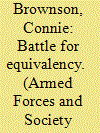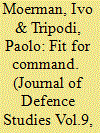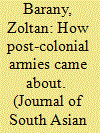|
|
|
Sort Order |
|
|
|
Items / Page
|
|
|
|
|
|
|
| Srl | Item |
| 1 |
ID:
136000


|
|
|
|
|
| Summary/Abstract |
After decades of debate, a void still exists in the literature and socio-political dialog related to the unrestricted and unbiased inclusion of women in the military. The issue remains so highly charged that a fresh theoretical framework is necessary to accurately align the physical and social constraints in which military women serve. Offered here are findings of an exploratory study framed within a synthesis of evolutionary psychological and sociological theory. Distinction between the word “equivalent” as opposed to “equal” is critical in recognizing the physicality, skills, and talents both males and females bring to their Marine Corps experience. Qualitative data obtained from 67 female Marine Staff Non-commissioned Officers, Warrant Officers, and commissioned officers describe tactics to achieve levels of operational competency, respect, trust, and success in the Marine Corps. An achievable goal, the successful woman must manage her physicality, sexuality, and femininity adeptly to achieve the trust and confidence of her male as well as female colleagues.
|
|
|
|
|
|
|
|
|
|
|
|
|
|
|
|
| 2 |
ID:
135010


|
|
|
|
|
| Summary/Abstract |
The socio-economic composition of the officer corps of the Continental Army has not received as much attention as that of the enlisted soldiers; the officers are generally assumed to have been members of America’s colonial elite. The need for large numbers of men to fill leadership positions in the nation’s first regular army presented an opportunity greater than at any time previous in America for the attainment of rank and status through an officer’s commission. Based upon research on the Maryland Line, this article argues that a larger segment of the Continental Army’s officer corps originated in a “middling” socio-economic range than currently thought.
|
|
|
|
|
|
|
|
|
|
|
|
|
|
|
|
| 3 |
ID:
137436


|
|
|
|
|
| Summary/Abstract |
Peace support operations (PSO)–counter-insurgency (COIN) operations are different and often significantly more complex than conventional operations. Such a complexity places greater demand on military leaders both at the tactical and operational levels. The diversity of tasks and threats, primacy of politics and the decentralized nature of PSO–COIN operations have serious implications for both junior and senior leaders. Although the fundamental leadership attributes for both conventional and PSO–COIN operations are timeless and common, in order to be successful in a PSO–COIN environment, military leaders should be more adept in certain attributes. This article, based on several case studies and a survey of military officers, shows that military leaders who possess and develop seven leadership attributes—adaptability, judgement, sociability, resoluteness, empathy, independence and knowledge/experience—are more likely to be successful at the tactical and operational levels in PSO– COIN.
|
|
|
|
|
|
|
|
|
|
|
|
|
|
|
|
| 4 |
ID:
134244


|
|
|
|
|
| Summary/Abstract |
The creation of an army loyal to the state is one of the most important institutional tasks of post-colonial leaders. But how do novice political leaders develop the capacity to subordinate the armed forces to the authority of state institutions? This essay explains alternative methods of formulating post-colonial civil–military relations and explains why four states – India, Pakistan, Ghana, and Tanzania – took such different routes of institutional development. I make two arguments. Firstly, building armed forces that willingly acquiesce to state authority is always a critical issue of regime change – whether to democracy or some other form of government – though it is more difficult to accomplish in some contexts than others. Secondly, the political and socioeconomic contexts in which armies must be built are very different and thus pose dissimilar challenges and tasks to those crafting new armies and civil–military relations. I will assess the power of several variables to explain the disparate outcomes of the four cases: the quality of political leadership and leaders’ approach to the armed forces, the strength of political institutions, ethno-religious and regional policies, civilian control mechanisms, military–societal relations, and foreign influence.
|
|
|
|
|
|
|
|
|
|
|
|
|
|
|
|
| 5 |
ID:
135984


|
|
|
|
|
| Summary/Abstract |
This AF&S Forum on National/Social Resilience includes four connected papers, each looking at the concept and its applications in different ways that are individually and collectively useful for a military leadership and practitioner audience. Each article, its perspectives, approaches, and implications, is briefly discussed in this Introduction, and also formally referenced in the hope that readers will engage the entire Forum. Moreover, the Forum authors hope that reader’s interest will be heightened leading to further research on this important topic.
|
|
|
|
|
|
|
|
|
|
|
|
|
|
|
|
| 6 |
ID:
134232


|
|
|
|
|
| Summary/Abstract |
It was October 2009, just days after a brazen Taliban attack on a remote American military base in eastern Afghanistan killed eight of the 53 members of his unit and wounded 27 others. The trim 29-year-old had hauled ammunition to pinned-down U.S. troops and killed close to a half-dozen Taliban fighters. His acts of bravery helped keep the tiny base from being completely overrun and later earned him the Medal of Honor, the U.S. military's highest commendation. Carter didn't feel like a hero, however. Alone at night, tossing and turning in his bed, he couldn't escape the sounds of that fateful firefight and the sight of Spc. Stephan Mace -- immobilized after his legs had been blown away -- begging for help, tears streaming down his dirt-covered face. Carter had raced across the battlefield and treated the 21-year-old's wounds, but, ultimately, Mace died during surgery just hours later. Carter felt that he had failed his comrade; if only he'd moved faster, he thought, Mace would have lived. And though Carter's platoon sergeant encouraged him to feel proud about having helped save other troops, "I couldn't really hear him," he said during a recent speech in Maryland. "I was more focused on getting to my bunk, burying my head into a pillow, and not existing. I wanted to find a deep hole and just disappear."
|
|
|
|
|
|
|
|
|
|
|
|
|
|
|
|
|
|
|
|
|